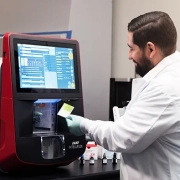AMLI 2022: Novel Assays for Clinical Immunology and Research
Multiplexing can streamline tests for food allergies, autoimmune diseases, and more
With the fall conference season already gearing up, we can’t help but reflect on the summer events we attended over these past few months. Most recently, Luminex representatives attended the annual meeting held by the Association of Medical Laboratory Immunologists (AMLI), which never fails to update attendees about news of the latest innovations and issues facing the diagnostic immunology field.
[thumbnail]
Once again, the VALID Act is center stage
AMLI 2022, held in Salt Lake City, brought together a community of healthcare providers, lab directors, clinical scientists, and commercial diagnostic developers for thoughtful dialogue and discussions about new breakthroughs. Once again, as it had been for clinical chemistry experts attending AACC 2022, the VALID (Verifying Accurate Leading-edge IVCT Development) Act proved to be a considerable concern within the diagnostic immunology community. There is apprehension across clinical laboratories about how this bill could affect laboratory-developed tests (LDTs) if voted into law. While tasking the FDA with LDT regulation has always been a hot-button issue among clinical lab professionals, there is great awareness of the pivotal role LDTs played in allowing healthcare teams to care for patients during the COVID-19 pandemic. AMLI attendees reaffirmed the need to ensure that patient care is always prioritized.
Many clinical lab users of Luminex assay platforms prefer the flexibility of creating their own LDTs based on Bio-Rad Laboratories hosted a seminar about HIV diagnostics featuring their xMAP-based multiplexed kit for HIV antigen and antibody detection. Thermo Fisher Scientific also gave a presentation about autoimmunity and data-driven approaches for analysis.
Of course, we would like to thank all the AMLI attendees who took time out of their busy event schedule to connect with us at our booth in the exhibit hall. We were excited to see so many researchers interested in learning more about xMAP multiplexing technology, as well as Luminex’s ability to support and streamline diagnostic and research needs within immunology using exponential speed and unmatched accuracy.
Learn more about our xMAP applications or check out our Kit Finder portal to see an evergrowing collection of available xMAP-based kits:
xMAP® Assays Reveal More About Immune Response than Traditional Vaccine ELISAs
AACC 2022: A Treat to Reconnect with the Laboratory Community
This year’s topics of interest included the VALID Act, GI testing, and dual-channel multiplexing technology.
Each summer at Luminex, we look forward to the annual meeting of the American Association for Clinical Chemistry (AACC). This year’s event at the massive McCormick Place venue in Chicago didn’t disappoint; it was a much-needed opportunity for Luminex representatives to reconnect with the laboratory community and share new ideas, discuss important issues such as the looming VALID Act, and survey the latest advancements in laboratory technology.
This year’s features
The meeting this year featured more than 275 expert speakers and an abundance of excellent educational opportunities for attendees. While much of the excitement among participants centered around the stellar sessions, we also noticed a great deal of enthusiasm about the community’s revived ability to meet at an in-person event. Networking with others in the clinical lab community is a major reason many participate in AACC each year, and it seemed attendees were eager to catch up, with attendance at post-session mixers and within the exhibit hall reaching nearly pre-pandemic levels.
The VALID Act
Naturally, the VALID Act was the subject of much discussion and at least one popular session. The bill has been working its way through Congress for several years now, and at AACC, there were experts on hand to discuss how the latest iteration of the legislation would affect laboratory-developed tests (LDTs) by requiring FDA oversight. We at Luminex are maintaining a close eye on this legislation since many of our customers design their own LDTs using our testing platforms.
Connecting through education
Other notable sessions covered a broad range of new technologies and updated approaches to clinical testing, particularly for improving diagnosis of GI-related conditions such as inflammatory bowel disease, irritable bowel syndrome, and celiac disease. Our parent company, DiaSorin, sponsored an educational workshop about primary aldosteronism, a rare condition that causes hypertension and for which there are highly effective treatments when a diagnosis is possible.

Poster presentations elevate xMAP® Technology
There were several posters presenting work using Luminex xMAP’s multiplexing technology. Key topics included developing a homebrew assay for reliably quantifying vaccine-induced immune responses, and a method comparison for detecting multiple biomarkers for classification of antiphospholipid syndrome and systemic lupus erythematosus. A popular presentation was the poster from Jeff Borgia’s lab at Rush University, identifying novel autoantibody biomarkers for use in lung cancer screening with a homebrew assay in companion diagnostics.
Presenting the xMAP INTELLIFLEX®
We were also honored by the tremendous interest in xMAP® Technology and impressed by our customers’ conference participation. If you attended AACC this year, we hope you enjoyed it as much as we did. We are already eager for AACC 2023!
Discover the dual-channel xMAP INTELLIFLEX® System.
Many stopped by our booth to learn more about the latest generation of xMAP Technology instruments.
Related Content:
Utility of xMAP For Multiplex Testing, Suspected Allergy, and Potential Cross-Reactivities in Food Samples (Food Testing)
A game changer: multiplex technology enables scientists to detect multiple food allergens simultaneously within a single well. One run, one sample.
According to the World Allergy Organization, allergic diseases are among the most prevalent diseases worldwide, and the burden of these diseases continues to increase. Fortunately, there are several methods that aid diagnosis including skin-prick testing and blood tests that evaluate IgE sensitization to specific allergens, also known as allergen-specific IgE (sIgE) blood tests. While the only way to truly diagnose a food allergy is to conduct an oral food challenge, there are drawbacks to this method: it is time consuming, labor intensive, and poses potential risk to patients’ health. Either way, once an individual knows they have an allergy to a particular food, they can choose to remove that food from their diet or limit its consumption.
Food labeling highlights an unmet need: a practical way to test a single sample for multiple allergens
Food labels are an important tool for informing individuals of the presence of potential allergens such as wheat, dairy, or peanuts, as well as related products. The 2004 Food Allergen Labeling and Consumer Protection Act facilitates consumers’ ability to determine which food products to avoid to maintain a safe and healthy diet. Food testing laboratories have also been working to respond to individuals with multiple food allergies and address the need to determine if there are suspected allergy- and cross-reactive proteins in food samples.
The xMAP® FADA enables food testing laboratories to efficiently detect multiple allergens within a single sample for the first time
Much of this research in allergy and food sensitization has prompted food testing laboratories to consider utilizing multiplex technology to measure allergens within food samples. The published article, Multi-laboratory validation of the xMAP®—Food Allergen Detection Assay: A multiplex, antibody-based assay for the simultaneous detection of food allergens, discusses how scientists from Radix and the Center for Food Safety and Applied Nutrition at the US FDA developed a robust food allergen detection assay using Luminex’s xMAP Technology. This assay deploys multiplex methods to detect 14 food allergens simultaneously, including gluten and sesame, within a single sample. The xMAP Food Allergen Detection Assay (xMAP FADA) enables increased quality control in food laboratories by testing for the presence of multiple food allergens at once.
The ability to test for multiple allergens simultaneously separates the xMAP FADA assay from conventional ELISAs. In a single workflow, the following allergens are analyzed: almond (-12, -13), Brazil nut (-14, -15), cashew (-18, -19), coconut (-20, -21), egg (-25, -26), gluten (-27, -28), hazelnut (-29, -30), macadamia (-33, -34), milk (-35, -36), peanut (-37, -38), pine nut (-39, -42), pistachio (-43, -44), soy (-45, -46), and walnut (-47, -48), as well as one antibody for crustacean seafood (-22). The extra quality control bead sets included in the assay help ensure robust performance among problematic food matrices such as meat sausage, orange juice, baked muffins, and dark chocolate. Validation established across multiple laboratories over a six-year period demonstrated excellent performance by analysts with varying lab proficiency.
Learn more about multiplex testing with xMAP Technology in our Resources section.
Discover the Possibilities Today!
Related Content:
- Robustness Testing of the xMAP Food Allergen Detection Assay: A Multiplex Assay for the Simultaneous Detection of Food Allergens [PUBLICATION]
- Multi-laboratory validation of the xMAP—Food Allergen Detection Assay: A multiplex, antibody-based assay for the simultaneous detection of food allergens [PUBLICATION]
- xMAP® Technology Overview [WEBPAGE]
6 Reasons You Should Attend xMAP® Connect
Luminex’s xMAP® multiplexing technology
Whether you’re a power user of Luminex’s xMAP® multiplexing technology or you’ve just heard about it for the first time, there’s a lot you can gain from attending one of our user group meetings. These xMAP Connect events are designed to be convenient, helpful, and educational. Still not convinced? Here are six reasons we think xMAP Connect meetings are worth your time.
1. They’re Local
Unlike typical biotech user group meetings hosted in the usual East Coast and West Coast hotspots, xMAP Connect is designed to bring great material right to users and prospective users wherever they are in multiple meetings throughout the year. We have upcoming events planned for La Jolla, CA, and Atlanta, GA, plus future meetings likely to be held in Chicago, Boston, and other locations as well.
2. No Commitment
We get it — you just don’t have the time or budget for a marathon, multi-day event. That’s why xMAP Connect takes place on a single day, making it easier for you to take time away from the lab or office to join us. We also share the agenda ahead of time, so if you can only pop in for the morning or afternoon, that’s OK. There’s still plenty to do in a short time!

3. Stellar Content
Speakers at xMAP Connect events are, in a word, fantastic. We are honored at every meeting to have highly respected leaders in their fields take time to join us and present results from their work with xMAP Technology. These talks are guaranteed to inspire new ideas, introduce novel applications, and inform users about different instruments and approaches.
4. Partner Presence
Luminex has commercialized much of its xMAP Technology through our dedicated partners — licensed companies that develop new assays based on our multiplexing tools. Many of these partners display their products at xMAP Connect events, giving attendees a great view of what’s available off the shelf.

5. Networking
xMAP Connect is for everyone, and we mean everyone! These one-day events bring together PIs and grad students, scientists and clinicians, technology developers and assay designers. When you’re not actively attending a presentation, you can take the opportunity to meet new people, exchange best practices, and collect new ideas to take back to the lab about how xMAP Technology can empower your research.
6. They’re free
There’s no cost for conference attendance, and we offer breakfast, lunch, and a cocktail hour as well—all completely free of charge.
We hope to see you at an upcoming xMAP Connect meeting!
Check out our next scheduled event for more information on how you can attend.
Related Content:
- xMAP® Connect: Advances in Aging and Dry Eye [BLOG]
- xMAP® Connect: Predicting Treatment Response in Breast Cancer [BLOG]
- xMAP® Connect: Measuring Immune Response for Vaccine Development [BLOG]
- Buyer’s Guide: How to Choose the Right Multiplex Technology for Your Needs [BLOG]
- Getting Started With xMAP® Technology [VIDEO]
xMAP® Connect: Advances in Aging and Dry Eye
Our recent user group meeting featured presentations of xMAP-enabled studies where multiplexing was essential
We were honored to host a number of terrific scientists at our recent xMAP® Connect user group meeting. In two of the talks, researchers reported on how they deployed Luminex’s xMAP® Technology for the analysis of tear fluid in patients with dry eye condition and for studies of anti-aging therapies.
Scleral Lens Wear: Managing Inflammation in the Fluid Reservoir
Maria Walker, an assistant professor at the University of Houston who pairs research with clinical time at the university’s eye clinic, spoke about a pilot study she performed to better understand the inflammatory response in patients suffering from dry eye, a condition affecting more than 50 million people in the US alone. For the study, she needed to analyze human tears — a remarkably complex fluid containing thousands of proteins, lipids, and metabolites.

To characterize these samples, Walker turned to xMAP Technology. She ran a cytokine panel to look for interleukins and matrix metalloproteinases. This first pilot study was designed to establish a robust protocol for collecting and analyzing tear fluid. In future studies, Walker hopes that her findings will eventually allow for a better understanding of the condition and offer the opportunity to evaluate new therapeutics.
Aging and Senescence: The Eternal Flame of Inflammation

In a separate presentation, Jair Espindola-Netto from the Mayo Clinic offered a look into his work on aging and senescence. Senescence, a cell fate associated with arrested growth but not apoptosis, is one of the mechanisms of aging. When senescent cells are injected into the knees of a healthy mouse, for instance, they induce the same kind of joint destruction associated with osteoarthritis, he said.
Espindola-Netto is using xMAP Technology to characterize proteins linked to senescence in translational research studies of anti-aging senolytic drugs, which aim to prevent senescence by making these cells less resistant to apoptosis.
He analyzed mRNA and cytokine markers in studies of a senolytic cocktail including dasatinib and quercetin, finding a significant reduction in senescent cells 14 days after treatment. He also identified a group of cytokines that appear to be correlated with the phenotype. Espindola-Netto noted that his goal is not to help people live longer, but rather to help them stay healthier as they age.
See Dr. Walker and Dr. Espindola-Netto’s full presentation here:
Check out these resources to see if xMAP Technology could be advantageous for your research.
Scientists Demonstrate Utility of xMAP® Technology for Studying Antibody Binding Kinetics
Multiplexing offers cost and time savings for generating critical kinetic data
Across the drug discovery and development process, understanding the kinetics of how antibodies bind is essential. This information is important for antibody selection, quality control processes, assay development for analyte detection, and much more.
Conventional techniques for generating kinetic data on antibodies tend to be tedious and time-consuming. Each antibody must be tested individually. For such important data, having a higher-throughput alternative would be ideal.
A new way to generate kinetic data on antibodies
Recently, scientists at the Fraunhofer Institute who study bioanalytics and bioprocessing (in the cell therapy and immunology division) evaluated a multiplex method for antibody kinetics. The Germany-based team is responsible for analyte detection in human health applications ranging from food contaminants and disease markers to drug abuse indicators and more. Led by Harald Seitz, head of the biomarker validation and assay development department, the team also included post-doc Sandra Muekusch and PhD student Timo Ramm. “The main aim of my work is trying to analyze all kinds of different samples,” says Seitz. “That involves a lot of quality control and other elements that are essential for assay development.”
For this project, they used the Luminex FLEXMAP 3D® System with bead-based xMAP® Technology capable of detecting up to 500 analytes in a single sample. Their study offers the first demonstration of how xMAP multiplexing can be used to generate kinetic data on antibody binding.
xMAP Technology passes the test
The scientists evaluated the xMAP-based approach by incubating different concentrations of a primary antibody with a fixed concentration of a secondary antibody, as well as direct labeling of the primary antibody. They calculated EC50 (effective dose, when 50 % of binding occurred) as the KD (binding affinity) value and compared the outcome to values obtained through conventional methods for measuring antibody binding kinetics. The work was based on peptides developed by Muekusch for phosphorylation studies.
“We compared Luminex to the gold standard of SPR, and the data looked good.”
— Timo Ramm, PhD student, Fraunhofer Institute
“I had worked with Luminex before, and it was quite easy.” The team notes that Luminex results would be particularly useful for ranking antibody binding kinetics, allowing researchers to quickly identify the best ones and move ahead to assay development.
The comparable results indicate that xMAP multiplexing technology is an efficient, high-throughput alternative for generating essential data about antibody binding patterns. xMAP Technology works with extremely small sample volumes, making it simpler and more cost-effective to test antibody binding for drug discovery and other applications.
Learn more about this project in our new tech note
Related Content
- Getting Started with xMAP® Technology [Video]
- xMAP® Cookbook to Design Your Own Assays [Download]
- Browse 1,200+ Partner Kits with xMAP® Kit Finder [Online Tool]
xMAP® Connect: Predicting Treatment Response in Breast Cancer
MD Anderson pathologist shares results from xMAP®-powered breast cancer studies at user group meeting
The recent xMAP® Connect user group meeting featured an impressive roster of speakers, and included among them was Fraser Symmans, pathologist and director at MD Anderson Cancer Center. His presentation offered an update on those projects designed to predict an individual’s breast cancer response to endocrine therapy—which is one of the most important and widely used long-term treatments available for those with HR+/HER2- breast cancer. Moreover, those clinical assays that interrogate therapeutic response have been supported by Luminex’s xMAP Technology.
xMAP Technology helps build platform for breast cancer studies
Symmans explained that his work began years ago, when his earliest assays were designed from microarrays that enabled the analysis of key transcripts. But as his team progressed, they aimed to create a customized assay that might eventually become a clinical test. They began by establishing a set of genes whose expression revealed information about the activity of an individual’s endocrine pathway and their correlation with cancer treatment. Over time, the scientists gathered data on endocrine therapy sensitivity, response to chemotherapy, burden of disease at diagnosis, and more.
Ultimately, Symmans’s team selected a group of genes that collectively serve as a prognostic index for endocrine therapy response. However, they wanted to move forward with an assay platform that could be used with Formalin-Fixed Paraffin-Embedded (FFPE) samples. Symmans and his colleagues compared an xMAP assay to the original microarrays, as well as to another gene expression technology and found excellent concordance across the platforms.
xMAP Technology serves as “a very stable platform”
“We made the choice for xMAP based on some preferences and some workflow logistics that we thought would be advantageous,” he said. It offers “outstanding performance” and now serves as “a very stable platform for us,” he added. Subsequent inter- and intra-lab studies demonstrated the platform’s strong reproducibility and “excellent concordance of this assay in different labs,” Symmans reported — noting that this was the case even for users who had no previous familiarity with the technology.
Symmans and his colleagues have used the xMAP-based assay to study various types of breast cancer samples as they expand their validation of the prognostic index. They have now assessed clinical utility in several different projects, predicting not only response to endocrine therapy, but also long-term survival. Their assay is now established in a CLIA laboratory, ready for use in prospective clinical trials and/or in commercial development projects.
Learn more about how xMAP Technology can be used for a wide variety of applications.
Related Content:
xMAP® Connect: Measuring Immune Response for Vaccine Development
Texas Children’s Hospital scientist speaks at our recent user group meeting about low-cost COVID‑19 vaccine
At the recent xMAP® Connect user group meeting, we were honored to host Jeroen Pollet, assistant professor at Baylor College of Medicine, who also serves as a director on the Vaccine Development Team at Texas Children’s Hospital. Pollet presented his insights regarding the application of xMAP Technology towards a multiplex cytokine release assay that measures immune response to vaccine candidates for tropical and other diseases.
Typically, Pollet and his team focus on surveillance, diagnostics, and vaccine development for neglected tropical diseases. “What’s truly unique about us is our science,” he said. The Vaccine Development Center is part of a special program that combines basic research with product development, as it spans preclinical and clinical testing—even seeing it through the regulatory review process. “It’s an integrated product development strategy,” Pollet added.
Shifting gears for COVID‑19
Upon the emergence of COVID-19, Pollet’s team turned its attention to this new public health threat and developed Corbevax®, which is an effective, low-cost vaccine that could supply low-income countries where other COVID-19 vaccines are cost-prohibitive. In addition to having received emergency use authorization and being commercially available, Corbevax has been licensed for production in India, where 300 million doses are being manufactured. There, it has already been used to vaccinate more than 10 million children aged 12 to 14. Moreover, 100 million vaccine doses have been approved and designated for Botswana, where manufacturers will begin ramping up local production.
Multiplexing technology offers ease of use, standardization, and the ability to query multiple analytes
This exciting development was made possible through the dedicated and tireless work of Pollet and his colleagues, who relied on Luminex’s xMAP Technology to make it happen. They used Luminex’s bead-based multiplexing platform in a pipeline with orthogonal technologies to test for an immune response following immunization. They chose the multiplex cytokine release assay for its ease of use, standardization, and its ability to query multiple analytes, Pollet informed. In preclinical studies involving mice, the assay allowed them to quantify the cytokines secreted after two doses of the vaccine. Subsequent studies were also performed in primate models. “It’s really important that we get data as fast as possible,” Pollet said. Because xMAP allows testing for multiple analytes at once, time to results is accelerated by eliminating the need for tedious serial testing.
xMAP Technology supports vaccine development
Pollet’s team works with both recombinant protein- and mRNA-based vaccines. In separate studies involving Chagas disease, Pollet relayed that a heterologous approach using both protein and mRNA looked very promising towards boosting immune response based on cytokine assay results. “We believe that heterologous vaccination is really the way forward,” he said.
Learn more about how xMAP Technology can be used to support vaccine development.
Multiplexing 101: New Resource for Immunoassays in Biomarker Discovery
Educational eBook offers tips and helpful examples
If you work with biomarker discovery, don’t miss out on this free eBook exploring how scientists can utilize multiplexing immunoassay technology in their research to generate more answers in less time with better reproducibility. Multiplex technology provides a high-throughput approach to biomarker research that saves time and money, minimizing the amount of samples and reagents required to perform an immunoassay.
Produced by BioCompare®, this eBook offers a variety of helpful tips for using multiplex tools as well as key tutorials, case studies, and other resources.
Some of the eBook highlights include:
- An introductory guide comparing multiplex immunoassays to single-plex immunoassays
- A look at how multiplex assays aid in the interrogation of conditions related to cytokines
- A case study demonstrating how multiplex assays can be used to detect protein and oligo targets by deploying a dual-reporter feature
- A comparison of multiplex assays to electrochemiluminescence showing differences in throughput and reliability of detection
- A look at simplified data analysis using improved immunoassay software
Backed by more than 50,000 publications, multiplexing immunoassay technology is a proven alternative to traditional ELISAs that can help scientists scale up their biomarker discovery operations while preserving samples.
For more information on multiplexing for biomarker discovery, download this free ebook today.
CDC Scientist Describes Multiplex Testing for Malaria at Immunology2022™
Antigen and antibody tests generate important data for characterizing population-level trends, individual immune response, and more
At Immunology2022™, this year’s meeting of the American Association of Immunologists, Eric Rogier, a microbiologist from the CDC, offered an exciting presentation about utilizing bead-based multiplex assays for generating epidemiological and immunological data about malaria.
Dr. Rogier, a specialist in malaria and other tropical diseases, aims to develop reliable diagnostic and serological tests to aid public health experts in their understanding of outbreaks, disease trends, and immune response. Unlike many tropical diseases that are easy to identify, malaria causes non-specific symptoms (such as fever, chills, headache, and nausea) that can be difficult to diagnose. In addition, asymptomatic infections are common in areas with high rates of transmission. This makes it difficult to estimate the true burden of disease, he noted.
Searching for several antigens at once with xMAP® Technology
Obtaining an accurate case count would allow researchers to track the effectiveness of treatments, monitor progress over time, and perhaps ultimately achieve disease elimination, Rogier informed. Thus, researchers require epidemiological data that is both accurate and plentiful. Unfortunately, the data generated by local health facilities is not always reliable or accessible.
To address these challenges, Rogier and his colleagues have developed multiple tests based on xMAP® Technology. The platform’s multiplexing capability is important for understanding malaria, which may be caused by four different Plasmodium species. By searching for several antigens instead of just one, xMAP-based assays allow users to distinguish species specific infections.
“A sandwich assay on three dimensions”
Rogier described the xMAP approach as “a sandwich assay on three dimensions.” Instead of being bound to a plate, he added, capture materials are bound to beads. The approach is also scalable and rapid, with a standard 96-well plate run requiring only three hours to complete. Rogier also noted his personal record for generating xMAP data hit 1,080 samples — 12 plates — in a single day.
His team has created several xMAP assays for malaria, with varying numbers of analytes. They have used a 9-plex assay to capture antigens of interest, including a Nigerian household survey that tested samples collected from more than 31,000 children. A separate study in Djibouti averaged 1,000 people and even allowed scientists to identify malaria co-infections of P. falciparum and P. vivax, thereby highlighting xMAP Technology’s cost advantage. Rather than spending $10 per sample on PCR tests for each person, the team spent $2 per sample and the xMAP assay yielded the same data, with results more comprehensive than any single-target test.
“Antibodies don’t lie”

Eric Rogier, PhD MPH, a microbiologist at the CDC, and his team have created several xMAP assays for malaria, with varying numbers of analytes.
In addition, Rogier has developed serological assays for antibody detection. “You’re looking at a history of exposure for an individual versus an active infection,” he said. This approach provides “an objective measure of malaria exposure in [a] population,” he added. “Antibodies don’t lie.”
Serology testing is especially useful in low-transmission settings, where generating enough data for epidemiological use can be challenging. In one example, Rogier showed that the antibody test identified 50 times more positive samples than tests for active infections. In another, he noted that serology data “can be a very powerful metric to assess population-level exposure.” Thanks to multiplexing, the tests can measure IgM, IgA, IgE, and all four subclasses of IgG.
Generating data for malaria—multiplexing makes it possible
Furthermore, a longitudinal study conducted in Angola offered scientists a view of the immune response to malaria, wherein patients were followed for 42 days with weekly sampling and serological testing. This study involved a 37-plex xMAP assay and led to new insights into antibody half-life and other dynamics. Interestingly, the results also made it possible to distinguish between patients who had malaria for the first time and those who had been infected more than once.
Together, these studies demonstrate that xMAP-based assays can cost-effectively generate rich epidemiological data for malaria in a variety of settings.
What range of applications can xMAP® Technology help with?
Discover the Possibilities Today!
Related Content:
DiaSorin S.p.A. - Share Capital €55.948.257 R.E.A. 180729 - Fiscal Code and Subscription to Vercelli Companies Register no 13144290155










